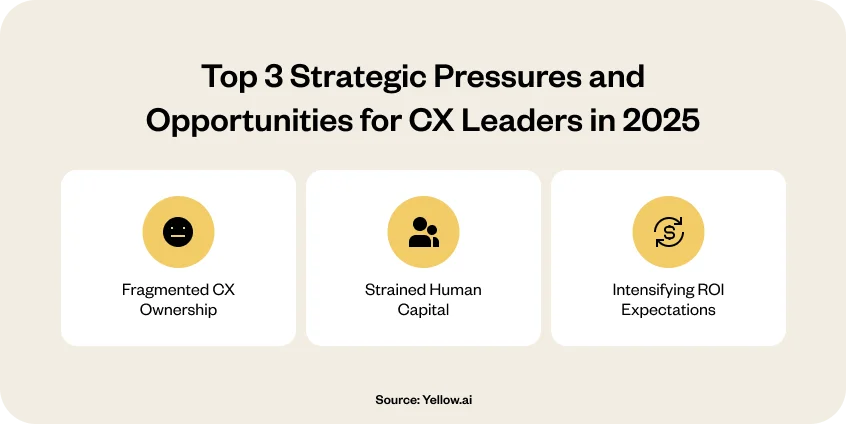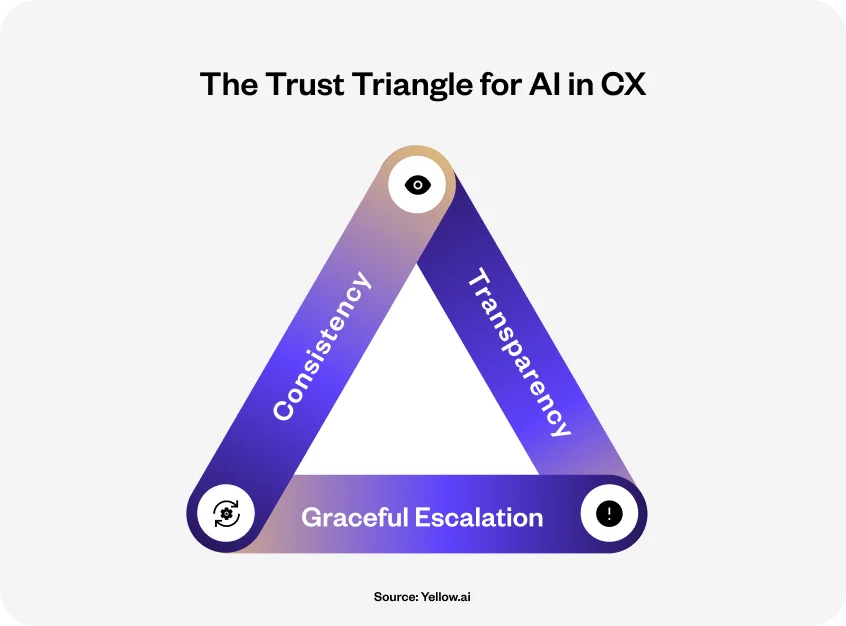Last month, in a conversation with a Fortune 500 CX leader, I heard a painfully familiar story – they’d invested millions in cutting-edge AI for customer support, yet their NPS scores had dropped for the third quarter in a row, and the complexity of the operations did not reduce.
“We have more technology than ever,” the CCO told me, frustration evident in her voice. “But somehow, we’re connecting with customers less.”
This disconnect isn’t isolated. According to Forrester’s 2024 CX Index, customer experience quality declined for 39% of brands in the previous year – the steepest drop since 2017. The data confirms what I’m hearing in conversations with CX leaders, even this year: more AI isn’t automatically translating to better customer experiences.
“The most common issue I see with companies implementing AI,” Omid observed, “is that they approach it with a technology-first mindset instead of a people-first one. Many of the organizations I advise have experimented with AI automation, but they’re often frustrated—because they’ve treated AI primarily as a cost-cutting tool, rather than as a means to reimagine the experience they want to create for customers, employees, and partners alike.“
This insight gets to the heart of what’s really happening in CX today – companies are investing in AI technology but missing the strategic mindset shift required to make it truly enhance customer relationships rather than just streamline operations. The technology-first approach creates automation without connection, efficiency without empathy, and ultimately, satisfaction scores that don’t match the investment.
Turning Pressure into Progress: The 3 CX Leadership Challenges to Solve in 2025
(Insights from Omid Razavi, Founder – SuccessLab)
In a recent advisory session with a healthcare tech company, the CX leader offered a telling insight:
“I’m responsible for retention and satisfaction, but I only control about 30% of what shapes those outcomes.”
This is a common theme, and a fixable one. Across industries, three recurring challenges continue to emerge. Forward-looking organizations are addressing them and using them as catalysts to redesign how customer experience is delivered, measured, and scaled.

1. The Ownership Opportunity – Aligning Around the End-to-End Journey
At a leading bank, a CCO shared a color-coded customer journey map by department. The takeaway was immediate: siloed ownership leads to siloed experiences. She managed the contact center, but key moments like onboarding, billing, and digital product use were controlled elsewhere.
The solution? Creating shared accountability for customer outcomes across teams.
Forward-looking organizations are establishing cross-functional CX councils and shared KPIs to drive alignment across the whole journey, from product to support.
2. The Human Opportunity – Empowering, Not Replacing, Your Frontline
One support leader saw team turnover reach 47% last year, more than three times the company average.
“My top agents are overloaded with repeat tickets while being asked to deliver empathy, handle multiple channels, and solve increasingly complex issues,” she noted.
The answer isn’t more pressure; it’s smarter support. When implemented thoughtfully, AI and automation can relieve agents of low-value, repetitive tasks and allow them to focus on high-impact interactions.
The best leaders are reframing automation not as a replacement strategy, but as an enablement strategy for their teams.
3. The ROI Opportunity – Building Trust Through Iteration
Yes, the pressure to deliver results is real and growing. In boardrooms, CX leaders are being told to accelerate AI adoption while keeping day-to-day operations stable.
“It’s like being asked to upgrade the aircraft mid-flight, just don’t cause any turbulence,” one executive said.
But the most successful teams are embracing this pressure with agile, phased approaches:
- Starting with clear, measurable use cases
- Co-creating implementation plans with stakeholders across functions
- And focusing on early wins to build internal momentum and trust.
With these the shift is rolled into motion from reactive firefighting to proactive value creation.
The Bottom Line
Each of these challenges – fragmented ownership, team strain, and ROI pressure – is an opportunity in disguise. By aligning teams around customer outcomes, empowering humans with the right tools, and approaching AI implementation with intention and transparency, organizations can not only meet expectations but set a new standard for customer experience in the AI era.
Why Your AI Isn’t Delivering (Yet)
(Insights from Mudit Garg, SVP – AI Strategy, Partnerships and GTM Ops, Yellow.ai)
Despite significant investments in cutting-edge tech, many organizations find their customer experience metrics stagnating or even declining months after implementation. Resolution accuracy, first contact resolution rates, and overall customer satisfaction often fail to show the promised improvements.
This happens not because the technology is flawed, but because in most cases they automate processes based on fundamentally outdated, inaccurate or incomplete information. The result? The automation amplifies existing problems rather than solving them.
This scenario reveals what I call the “AI Readiness Gap“. After analyzing hundreds of our most recent implementations at Yellow.ai, we’ve identified four critical foundation elements that cannot be shortcut:
- Data Foundation First – Without clean, unified information, AI merely becomes a faster way to deliver inconsistent and inaccurate responses and interactions, eroding away customer confidence.
- Precision Over Breadth – Solving specific problems completely delivers more value than partially addressing many issues when you are starting out. This not just builds trust for the implementation for all stakeholders.
- Cross-Functional Buy-In – Product, IT, legal, and operations must move in lockstep for successful implementation. Silos kill AI success rate. It is not a one-function project.
- Customer-defined Boundaries – AI guardrails must be shaped by customer needs, not just technical limitations.
Case in point: At Yellow.ai, we’ve worked with enterprises that achieve significant automation in L1 and L2 support within months, but only after investing in clear use cases and cross-functional alignment. One large tech client recently hit 70% automation, including escalation handling and it continues to improve as the AI learns from each interaction.
You might also like: The Impossible Ask of Delivering World-class CX at Scale While Cutting Costs; and the AI Promise
How to Build AI That Earns Trust, Not Resistance
(Insights from Omid Razavi, Founder – SuccessLab)
In a recent conversation with a senior support engineer, I heard something that spoke volumes—more than any dashboard or survey ever could. Despite her company’s multimillion-dollar investment in a new AI assistant, she was intentionally avoiding it.
“Why don’t you use it?” I asked. “Isn’t it supposed to make your job easier?”
She replied, “I tried it several times when it launched. Each time, it confidently gave me the wrong answer, and I had to clean up the mess. I just don’t trust it anymore.”
This moment crystalized a pattern I’ve seen time and again: trust is the hidden currency of AI adoption. The issue isn’t usually with the AI itself, but with poor implementation—tools that create friction for employees and deliver inconsistent experiences to customers.
So how can organizations design AI that builds trust instead of breaking it?
The AI Trust Triangle
Trust and empathy are prerequisites to scaling AI. Once trust is earned, organizations can move from asking “Can we automate this?” to confidently enabling AI agents to make decisions, escalate intelligently, and collaborate across channels.
Here are the three pillars of the trust triangle:

The most successful AI programs are grounded in three essential principles:
1. Transparency
One financial services firm improved customer satisfaction by 26%—without changing the underlying technology—by simply making their AI assistant visibly non-human. Customers appreciated the clarity, which reduced confusion and increased acceptance.
Being honest about what AI is (and isn’t) builds immediate credibility.
2. Consistency
A hospitality company I advised started tracking “AI promise breaks”—situations where the virtual agent committed to a follow-up or resolution but failed to deliver. By fixing these inconsistencies, they saw measurable improvements in CSAT and resolution times.
Customers will tolerate limits, but not letdowns.
3. Graceful Escalation
A travel company reduced escalation-related complaints by 53% by ensuring that AI agents passed full context to human agents during handoffs. Eliminating the need for customers to repeat themselves created a smoother, more respectful experience.
When escalation is seamless, trust is preserved.
AI should enable people, not replace them. It should enhance the customer experience, not just automate it. Organizations that prioritize trust and design with intention are the ones transforming AI from a cost-cutting tool into a loyalty-building advantage.
Because in the end, you don’t scale AI; you scale trust.
From Here to What’s Next
(Insights from Mudit Garg, SVP – AI Strategy, Partnerships and GTM Ops, Yellow.ai)
Looking toward the future, one thing is abundantly clear from my work with CX teams across industries: the organizations that will thrive aren’t choosing between technology and humanity – they’re thoughtfully blending both.
“What experience do we want to create?” rather than “How can we implement more AI?”
This mindset shift of viewing AI as the solution to seeing it as one component of a customer-centered strategy—marks the divide between organizations struggling with the paradox of doing more with less and those moving beyond it.
The future of customer experience won’t be fully human or fully AI-driven. It will be a partnership between speed and nuance, between AI that scales and humans that innovate.
But this partnership will only succeed if we build with intent.
Curious what over 80% automation on L1/L2 support actually looks like?























